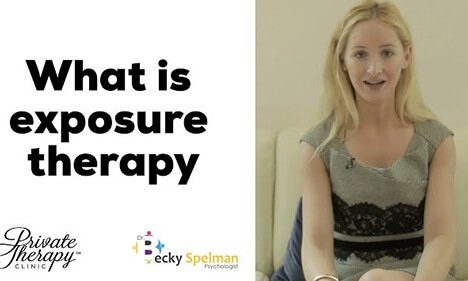In this video Dr Becky Spelman talks about exposure therapy and why it is so good for overcoming anxiety. Exposure therapy is a CBT technique which is very useful in helping people overcome anxiety as it helps people learn to sit with their distress and overcome it. Over the year Dr Becky has worked with numerous clients both in person and over video call helping them overcome anxiety disorders such as panic attacks and phobias.
Video Transcript
I’m going to talk about exposure therapy and why this is so powerful for anxiety disorders. I’ve been using exposure therapy for a really long time with my clients to help a whole range of disorders such as phobias, health anxiety, OCD, social anxiety, panic disorder and other anxiety disorders.
The reason it is so powerful is when someone is anxious, they are terrified, and they don’t want to be experiencing those uncomfortable feelings. Quite naturally, they want to avoid but in order to help people overcome many anxiety disorders, I encourage them to go into the situation and sit with their fears. Usually, people don’t want to do this. This is why I like to work quite closely with people either being there in the situation or being on the other end of the video call, convincing them to go into the situation and stay there for long enough for their anxiety to subside.
The example of this is a client that I was working with in London. He was terrified of enclosed spaces for fear of having a panic attack. I took him to what’s known as the Emirate’s Carts which is these carts in Greenwich, in London, they go over the water, you just tap what your contactless card to get on, door closes and then you go over the river but once you’re in, you’re in. That’s a ten minute journey. You cannot get out. It’s very enclosed space, quite small. It only fits a couple of people. This client was absolutely terrified. He really wanted to overcome his fear and he had signed up for intense package of training with me so we scheduled six hours where we are going to do some really challenging things. This was one of the activities. We had got to the entrance of the carts and it’s then my job to convince him to go on. He was paying a lot of money to see me so I knew I had to get him to go on. I knew that he wanted to do it even though his emotions were saying no. We’re at the entrance. He’s saying “No, no. I’ve changed my mind. I don’t want to go on.” I just kind of guided him. I sort of like grabbed his wrist and I just kind of said we’re doing it. Maybe that sounds a little bit aggressive but I knew that he would be okay. I had lots of strategies to show him once we were in there so I knew he thanked me for it later. We had a good rapport so it wasn’t like I was just forcing this person I didn’t know to do something that he was terrified of. We’d had lots of consultations beforehand before this big day of doing lots of exposure. He had signed up for this. It was fine but it might sound like a bit of an aggressive move to force someone into a situation when they’re screaming saying no. But I had his consent so I pushed him into the cart, it closed. He’s terrified, still saying no. He actually did have a panic attack which interestingly enough was one of his worst fears.
You might ask why would I want someone to experience their worst fear. Well, the reason I wanted him to have a panic attack is because when people are scared of having panic attacks, they always try to avoid that. They think that a panic attack is going to be the worst possible thing that could happen but actually with this client, he was having a panic attack and then, I just got him to look over the water and just tell me some things he was noticing. Straight away, his focus went away from the panic attack. His anxiety came right down. He started to enjoy the scenery and started to say things like “I’m okay now. I feel much better.” And then he started to smile and laugh. He couldn’t believe he was there, coping with the situation.
Quite quickly, in a matter of minutes, he went from having a panic attack and not coping very well to actually just changing his focus of direction, realising he could sit with the high level of anxiety he was experiencing and it wasn’t causing him to faint, collapse or anything awful to happen to him which is often what people predict when they think they’re going to have a panic attack or when they have fear of having panic attacks. And then we got to the end of the journey. He gave me a big hug, and he said “Thank you so much for making me go on to that thing. I’ve been avoiding that for 10 years. I have just been terrified of enclosed spaces.” There was lots of things he couldn’t do: he couldn’t go up in lifts, anywhere enclosed. Even being in his car was quite terrifying. Any place where he felt he couldn’t escape easily was a massive trigger for him.
That was one example of intense exposure therapy where you just really go for it. In my job as a therapist, I really try and get people to just stop avoiding and go straight to their worst fear. This was one of my client’s worst fears. Afterwards, his beliefs have changed. He realised that actually, he didn’t need to avoid this thing anymore. The anxiety he thought he was going to experience was not actually going to be completely unmanageable, that he could sit through the high levels of distress. While it wasn’t comfortable, it wasn’t something that he completely couldn’t tolerate. And then he did it feel more times and then, it was like nothing.
It was like watching a horror movie a hundred times. Yes, the first time was awful. With time, you just get really used to the experience. In fact, you kind of get bored. You just can’t have that same reaction over and over when you stop avoiding things. This is why exposure therapy is so important to many different anxiety disorders and is really key in the treatment of overcoming anxiety disorders. If you’d like this video, please subscribe to my channel. Also, if you do want further advice on any type of anxiety disorder, you can contact myself at the clinic.
WHO CAN I SPEAK TO FURTHER ABOUT THE ISSUES IN THIS ARTICLE?
For help with the issues discussed in this article speak to one of our therapists here at Private Therapy Clinic for a free initial chat or to make an appointment.













